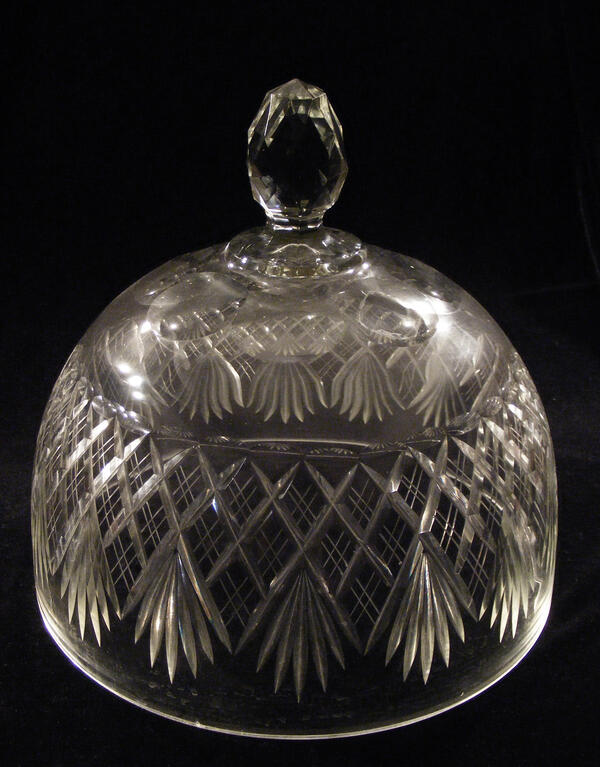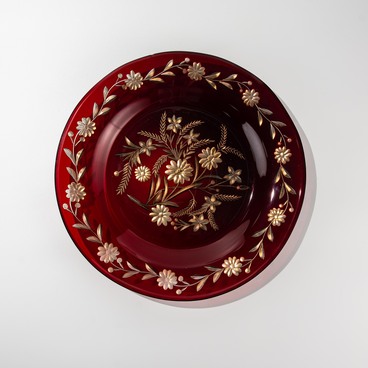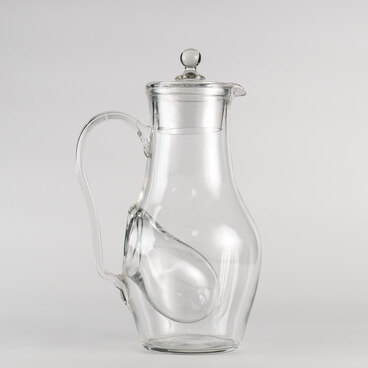A cheese dome is a special lid covering a stand for serving cut cheese. Cheese varieties can have a peculiar, sometimes very strong smell. To prevent this smell from tainting other dishes on the holiday table, a cheese dome is used. In the 19th century, this product was part of a large “Bushes and Nets” set (also known as the “Bushes and Diamonds” service). This rather unique name is determined by the deep-cut or diamond-shaped pattern used for decorating the service, including a pitcher, a decanter, a vase for sweets, drinkware, and many other items.
Diamond-shaped cutting is the term that is used in Russian to describe the use of deep-cut patterns on crystal items. This technique was developed in England in the 1780s and is still used nowadays. In the first half of the 19th century, the most popular type of facet was made using a disc at a 45º angle and had V-shaped cuts, which crossed to form certain images. A “diamond” or a “simple diamond” is a pattern of diagonal cuts which cross to form four-sided pyramids. A “stone” is a prismatic pattern where the surface is covered with net-shaped cuts. Its most popular version is the world-famous “Russian stone” where the prism surface is an octagon. In the case of a “step” or “ring” cut, sharp horizontal edges fit tightly close to each other. A “net-shaped” or “dashed” pattern consists of several crossing shallow cuts. At the turn of the 20th century, there were so many deep-cut patterns that they were assigned not only names but also numbers in the factory’s price lists. The distinctive feature of numbered cutting was that the patterns consisted of several basic elements, such as “fingers”, “pits”, “rails”, “beams”, “bushes”, “nets”, and “cobwebs”. The craftsmen of the Dyatkovo Crystal Factory kept searching for new deep-cut patterns that would allow them to use the decorative properties of crystal — the rainbow-like play of colors and the precious shining — in the best possible way.
Diamond-shaped cutting is the term that is used in Russian to describe the use of deep-cut patterns on crystal items. This technique was developed in England in the 1780s and is still used nowadays. In the first half of the 19th century, the most popular type of facet was made using a disc at a 45º angle and had V-shaped cuts, which crossed to form certain images. A “diamond” or a “simple diamond” is a pattern of diagonal cuts which cross to form four-sided pyramids. A “stone” is a prismatic pattern where the surface is covered with net-shaped cuts. Its most popular version is the world-famous “Russian stone” where the prism surface is an octagon. In the case of a “step” or “ring” cut, sharp horizontal edges fit tightly close to each other. A “net-shaped” or “dashed” pattern consists of several crossing shallow cuts. At the turn of the 20th century, there were so many deep-cut patterns that they were assigned not only names but also numbers in the factory’s price lists. The distinctive feature of numbered cutting was that the patterns consisted of several basic elements, such as “fingers”, “pits”, “rails”, “beams”, “bushes”, “nets”, and “cobwebs”. The craftsmen of the Dyatkovo Crystal Factory kept searching for new deep-cut patterns that would allow them to use the decorative properties of crystal — the rainbow-like play of colors and the precious shining — in the best possible way.



